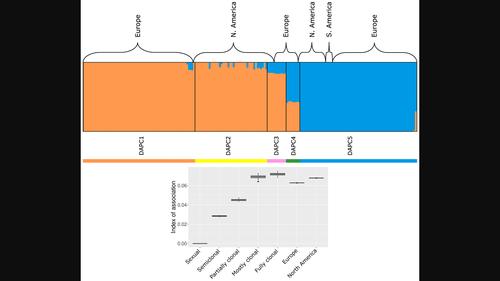当前位置:
X-MOL 学术
›
Mol. Plant Pathol.
›
论文详情
Our official English website, www.x-mol.net, welcomes your feedback! (Note: you will need to create a separate account there.)
Phylogeography, origin and population structure of the self‐fertile emerging plant pathogen Phytophthora pseudosyringae
Molecular Plant Pathology ( IF 4.9 ) Pub Date : 2024-04-09 , DOI: 10.1111/mpp.13450 Martin S. Mullett 1 , Anna R. Harris 2 , Bruno Scanu 3 , Kris Van Poucke 4 , Jared LeBoldus 5, 6 , Elizabeth Stamm 5 , Tyler B. Bourret 7, 8 , Petya K. Christova 9 , Jonás Oliva 10, 11 , Miguel A. Redondo 12, 13 , Venche Talgø 14 , Tamara Corcobado 1 , Ivan Milenković 1 , Marília Horta Jung 1 , Joan Webber 2 , Kurt Heungens 4 , Thomas Jung 1
Phytophthora pseudosyringae is a self‐fertile pathogen of woody plants, particularly associated with tree species from the genera Fagus , Notholithocarpus , Nothofagus and Quercus , which is found across Europe and in parts of North America and Chile. It can behave as a soil pathogen infecting roots and the stem collar region, as well as an aerial pathogen infecting leaves, twigs and stem barks, causing particular damage in the United Kingdom and western North America. The population structure, migration and potential outcrossing of a worldwide collection of isolates were investigated using genotyping‐by‐sequencing. Coalescent‐based migration analysis revealed that the North American population originated from Europe. Historical gene flow has occurred between the continents in both directions to some extent, yet contemporary migration is overwhelmingly from Europe to North America. Two broad population clusters dominate the global population of the pathogen, with a subgroup derived from one of the main clusters found only in western North America. Index of association and network analyses indicate an influential level of outcrossing has occurred in this preferentially inbreeding, homothallic oomycete. Outcrossing between the two main population clusters has created distinct subgroups of admixed individuals that are, however, less common than the main population clusters. Differences in life history traits between the two main population clusters should be further investigated together with virulence and host range tests to evaluate the risk each population poses to natural environments worldwide.
中文翻译:

自花授精新兴植物病原体假丁香疫霉的系统发育地理学、起源和种群结构
假丁香疫霉 是木本植物的自花授粉病原体,特别与以下属的树种有关水青冈属 ,石果属 ,水青冈属 和栎属 ,遍布欧洲以及北美和智利的部分地区。它可以作为感染根和茎颈区域的土壤病原体,以及感染叶子、细枝和茎皮的气生病原体,在英国和北美西部造成特别的损害。使用测序基因分型研究了全球分离株的种群结构、迁移和潜在异型杂交。基于聚结的迁移分析表明,北美人口起源于欧洲。历史上,大陆之间的基因流动在某种程度上是双向的,但当代的移民绝大多数是从欧洲到北美。两个广泛的种群集群在全球病原体种群中占主导地位,其中一个亚群源自仅在北美西部发现的主要集群之一。关联指数和网络分析表明,在这种优先近交的同宗卵菌中发生了有影响力的异型杂交。两个主要种群集群之间的异型杂交产生了不同的混合个体亚群,但这些亚群不如主要种群集群常见。应进一步研究两个主要种群群体之间生活史特征的差异,并结合毒力和宿主范围测试,以评估每个种群对全球自然环境造成的风险。
更新日期:2024-04-09
Molecular Plant Pathology ( IF 4.9 ) Pub Date : 2024-04-09 , DOI: 10.1111/mpp.13450 Martin S. Mullett 1 , Anna R. Harris 2 , Bruno Scanu 3 , Kris Van Poucke 4 , Jared LeBoldus 5, 6 , Elizabeth Stamm 5 , Tyler B. Bourret 7, 8 , Petya K. Christova 9 , Jonás Oliva 10, 11 , Miguel A. Redondo 12, 13 , Venche Talgø 14 , Tamara Corcobado 1 , Ivan Milenković 1 , Marília Horta Jung 1 , Joan Webber 2 , Kurt Heungens 4 , Thomas Jung 1
Affiliation

|
中文翻译:

自花授精新兴植物病原体假丁香疫霉的系统发育地理学、起源和种群结构



























 京公网安备 11010802027423号
京公网安备 11010802027423号